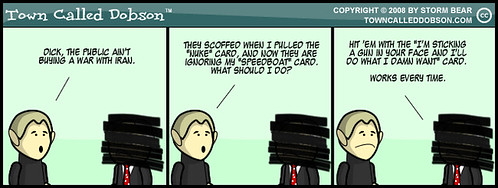Crossposted from Left Toon Lane, Bilerico Project & My Left Wing

click to enlarge
As any sailor will tell you, deploying a naval battle group into a small body off water like the Persian Gulf is difficult, when you drop three or four battle groups in there, it becomes insane. You put that many ships in such a confined space and then add all the normal seafaring traffic in the Gulf and you have a recipe for disaster – with habanero sauce.
Here is a question I want answered, where are the US Naval ships? In the Straight of Hormuz, there are no international waters – you are either in Iran’s or Oman’s territory. The United Nations Convention on the Law of the Sea provides transit passage through this area. So if Iranian boats are mingling with US ships, what are we doing in their waters? The Convention established guidelines for businesses, the environment, and the management of marine natural resources. But the US Senate has yet to sign the Convention. Military vessels also have the right of “innocent passage” defined by the convention as passing through waters in an expeditious and continuous manner, which is not “prejudicial to the peace, good order or the security” of the coastal state. Fishing, polluting, weapons practice, and spying are not “innocent”, and submarines and other underwater vehicles are required to navigate on the surface and to show their flag. Nations can also temporarily suspend innocent passage in specific areas of their territorial seas, if doing so is essential for the protection of its security.
As I read the Convention, we have no right being there.
Also, if all of our ships are in Oman’s territory, isn’t Oman upset that these boats are in there territorial waters? I doubt it. Oman has one of the largest ports in the world and there is a lot of small boat traffic coming and going from Iran – been that way for a very long time. In other words, boat traffic from Iran is normal, our presence there, clogging up the works with such a heavy-handed posture.
Now we learn this last event, was not the first time boats came within “the safety zone” of the US Navy. (The size of the safety zone is also something that hasn’t been released as far as I know.) According to new evidence, these close encounters are common. The audio the Pentagon presented as part of the video turns out not to be associated with the video. There is no evidence the audio came from the boats in questions. Further evidence shows the audio may not have happened on the same day, nor associated with any boat. Even the Navy admits these were not a threat.
Here are the questions the MSM are unwilling to answer…
- Whose waters was USS Port Royal in, Iran or Oman?
- Did the USS Port Royal have permission to be in those waters?
- What was the destination of the USS Port Royal? Was it complying with innocent transit guidelines or was it parked waiting to scrap with someone?
- What is the size of the safety zone for the USS Port Royal. If you can’t tell the American people, how are the Iranians supposed to know?



The Newport News a US submarine struck a Japanese large tanker while submerged. Against protocol, as far as I understand your info.
There also is no area of international water, as you state, It`s Iranian/ Omani & further northeasterly,it is Iranian/UAE.
Yet, & I may be wrong on this, I thought I had heard a response from an Iranian query, by an American vessel, as being in International water.
Having been involved in disputes at sea along the lines of being in environmental waters, territorial waters or international waters, I clicked on it when I thought I heard that phrase. I also knew about the agreed upon boundaries in that area between Oman, Iran & the UAE, so something did not seem right.
I`ve also been involved in much worse close quarters skirmishes at sea with much larger vessels although it was still a David & Goliath situation.
The situation is one of, when/not if, a mistake of great proportion will take place.
But that`s only my opinion.
Everybody has a right to transit the Strait by rule of international maritime law.
That is correct, although right of passage, does not make it “international waters”.
That right may also be rescinded in certain circumstances I believe.
It is an agreement to allow transit through the strait, not to cruise for trouble.
The limited capacity for safe transit through this critical bottleneck is going to be surpassed, & probably by a minor error of judgement.
Just having these warships in that area, is a recipe for such an event.
I am not suggesting that the US is there to provoke, but only that by being there, in those numbers, could lend one to believe so. We all know what only one simple-nutcase can do to provoke global animosity.
“The regime of transit passage retains the international status of the straits and gives the naval Powers the right to unimpeded navigation and overflight that they had insisted on. Ships and vessels in transit passage, however, must observe international regulations on navigational safety, civilian air-traffic control and prohibition of vessel-source pollution and the conditions that ships and aircraft proceed without delay and without stopping except in distress situations and that they refrain from any threat or use of force against the coastal State. In all matters other than such transient navigation, straits are to be considered part of the territorial sea of the coastal State.”
http://www.un.org/Depts/los/convention_agreements/convention_historical_perspective.htm